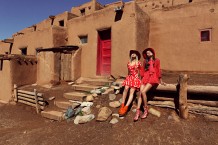It began with a phone call in November. “Hi!” a chirpy voice crackled on the other end of the line. “It’s Adaobi! From Zambia!” I am not an idiot or anything, but I had to dig deep into my high school repertoire to remember where Zambia was. Definitely in Africa. After a few awkward, delayed seconds, and a geographical adjustment of my brain, I managed to fumble: “Uh hi! How did you find my phone number??” It turns out Miss Mwanamwambwa had studied in Vermont, and was quite familiar with our neck of the woods. She had a little start-up shoe company called Tau, all “handmade in Africa” and wanted me to style her look book and help launch the brand in the US.
Fast forward eight months, fifteen hundred e-mails, one Skype call and a grueling 37-hour trip to Lusaka, I am standing behind a projector in front of a class of about 25 students, girls and boys who have signed up to take my two-day workshop. By now the shoe launch has taken a back seat and Adaobi has devised bigger and nobler plans for me. Tau has turned into a Foundation set out to connect African and Western women, and is working closely with the new Fashion Council, a rudimentary local attempt at bringing structure and guidance to the barebones Zambian fashion industry.
Because barebones it is, as I soon discover. In the first half hour of the class I find out that there is no fashion magazine in Zambia, that designers are asked to style, cast and organize their own fashion shows, that the chitenge textiles are imported from China and Holland and that none of the young designers sell through e-commerce. Despite these alarming bits of information, I get very excited, because the young people in this room are destined to be the front runners of change and progress, the catalysts of a new fashion landscape, and I see little lights go off in their eyes as I start explaining how they can organize themselves and create a real industry.
Let me give you a few facts first. Zambia is a huge country, in size slightly larger than Texas, but has a population of less than 15 million. The death rate is high. Very few people have access to health care and the HIV epidemic is a considerable problem, affecting more than 19% of the working population. Statistics estimate however that Zambia’s population will double within the next twenty years. The economy is growing exponentially, with ups and downs, and the rising middle class has an increasing disposable income. Young girls are looking to spend, whether it’s on a brand new cell phone or the latest fashion accessories, they’re out there dropping their hard-earned cash and their boyfriends’. The last few years giant malls have been popping up all over the capital of Lusaka, with chains like Pizza Hut, ShopRite, Woolworth’s and primarily South African fashion brands becoming household names. Traffic is in daily gridlock, fiber optic cables are being dug in all over the city and the construction companies are thriving.
Africa as a continent is a new economic force, comparable to what China was in the 80s – no one saw the Chinese as a threat then but things were brewing. Some countries like South Africa and Nigeria are already playing on the international field, but Zambia is catching up, albeit slowly. My pupils are designers, photographers, models, stylists, teachers and art students. They all have talent and they’re very creative but they’re working on an individual level, not as teams. Musha for example works from her studio in her mother’s backyard, creates and sews her own designs, then sells her one-off pieces to regular clients, probably over the phone. It’s a solo operation. The same goes for her friend Debbie Chu. The only ones that seem to be growing and expanding, and have real inventory are Kamangawear and Towani of Kutowa Designs. The latter started six years ago in her living room with one seamstress and now has a studio with at least ten employees, and she’s in the process of creating an e-shop. (The problem with production is that you can only buy so much fabric in Zambia. When it runs out, you cannot find more of the same. Zambia’s textile industry is considered to have vast competitive potential in the region due to relatively cheap labor costs and a high level of domestic cotton production. But the dumping of cheaper foreign textiles on the Zambian market by regional competitors has negated the growth of domestic textile production.)
What is missing in Zambia is a platform for all these young creatives to show off their work and collaborate. Instagram is popular, but very few people have a blog or a website to self-promote. One girl tells me it’s because cell phone data is expensive. But that’s about to change too. I explain to the class how a life style magazine could create many different jobs, each with their specific duties: from graphic designers to photographers, from art directors to models, from writers to stylists. (A few print magazines existed but they all folded, primarily because they were too expensive and nobody was buying them.) There is no fashion eduction either. Just one of the colleges has a fashion class. If there was a fashion magazine, and a need to fill each role with trained people, then these classes could become part of an extensive fashion program.
The Fashion Council has recognized all these problems and is now trying to lobby with the government to make changes and raise money to create an infrastructure for all the creatives to work together and sustain a self-sufficient industry. When I speak with the Minister of Arts and Culture at the reception that night, I carefully relay all I’ve learned and encourage her to support their initiative to start up an on-line magazine. I know we are both sipping mango Bellinis but when she shakes my hand and says, “I am happy I came tonight!” I detect a twinkle in her eye too. There’s a lot of work to be done in Zambia, but if everyone pulls together and keeps the fire going, Zambia’s fashion talent will be on the map soon!
Big thanks to Adaobi Mwanamwambwa and Gloria Huwiler for taking care of me. And to all the girls and boys who showed up and learned as much from me as I did from them!
Also a big thanks to all the sponsors who made it possible for me to visit Zambia: R & G events, Budget Stores, Pilatus, Akasuba, Nkwashi, Technet, Shreeji investments, African Grey, Melissa Supermarket, Latitude, The Royal Livingstone












































































This is very exciting. Africa has so much to offer.
What a great article about Nambia! Thank you for sharing your beautiful travels! 🙂
Namibia? This article is about Zambia.
Thank you Natalie,Learnt a lot and yes the Zambian Fashion industry is growing and am Happy to be part of it.
Well done, Joos! Uganda was my home for a time and the fabrics from the continent are beyond spectacular…Sadly, many traditional cloths are giving way to cheaply imported textiles, as you reported. Thank you for empowering the students and revving up the palate for everything but mundane! I think I need to wear something colorful tomorrow!
Great insightful article that truely depicts how Zambia is and the great potential it has. You have definitely opened my mind to how much greater the fashion industry will be once we invest in our own textiles cause clearly the talent is there.
This is beautiful Natalie. I really enjoyed reading your input and thoughts on your trip to Zambia. We really appreciated it and hope to see you here soon. 🙂
Really interesting was in Zambia last month after not visiting for ten years and the rate development is astounding.
I have been dreaming of this for such a long time. Well done Ms Mwanamuambwa and Natalie. And to all that attended this class, waiting to see this take off. Smiling from ear to ear reading this article.
Incredible and insightful read! It’s amazing how designers have to work thrice as hard to get their brand out.
♡ veena | seveninchstilettos.com
twitter/instagram: @veenamccoole
My friend’s Adaobi and Gloria way to go! You guys rock!b I just shared this on Facbook 🙂
Thankyou for this piece on Zambia. I have such special memories of this beautiful country and especially warm and wonderful people .memories dating from the late 70’s so I am happy to hear of the progress and the fact that the people have retained their warmth and enthusiasm.
What a great story! This is an amazing time for African countries. It’s exciting to see that with government support of the industry this could be a thriving sector in the not-too-distant future.
Best of luck!
Great article I left Zambia in 1973 to persue a fashion design course at London college of fashion after doing a art foundation course in Evelyn hone College.Still a designer offering lessons, fashion services to fashion industry and individuals. you can view my site roseanndesigns.weebly.com, Facebook pages Roseann-designs, and Nkayezi.weebly.com and nkayezi Facebook pages.